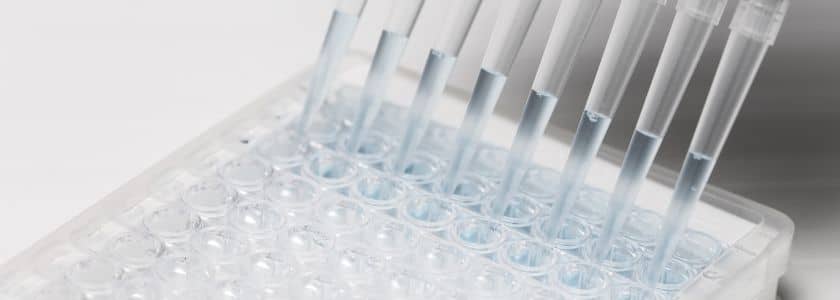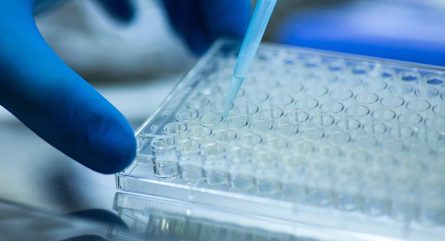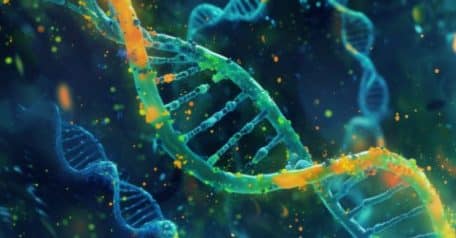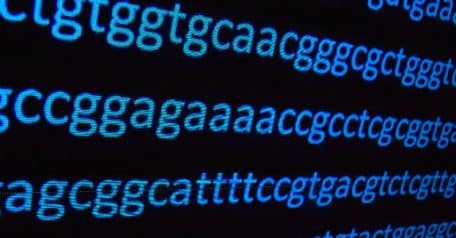The takeaway: Digital PCR is an advanced tool for measuring the number of target molecules present in a sample. An improvement over traditional PCR, it enables precise and highly sensitive quantification of nucleic acids.
Polymerase chain reaction, or PCR, is a lab technique for quickly amplifying thousands, million, and even billions of copies of a small amount of a specific DNA sample so it is large enough to study in detail. A bench standard for decades, PCR went truly mainstream during the COVID-19 pandemic, when reverse transcription PCR tests were designed to detect SARS-CoV-2 genetically.
While PCR is a vital tool in many genetic research practices, it is important to understand a more recent offshoot of PCR—digital PCR, or dPCR. Let’s answer some common questions about dPCR and why it is useful.
What is digital PCR?
Digital PCR, or dPCR, is an improved version of traditional PCR that can directly quantify and amplify nucleic acid strains such as DNA and RNA. Digital PCR works by dividing a sample into many individual micro reactions, which then undergo PCR amplification and analysis separately. Like traditional PCR, the digital method measures a variable using a single reaction within a sample, but the sample is separated into a large number of parts and the reaction happens on each part individually. This separation permits more reliable collection and measurement of nucleic acid amounts.
Who invented digital PCR?
The term “digital PCR” can be credited to Kenneth Kinzler, who was the co-director of the Ludwig Center at Johns Hopkins University. Working with colleague Bert Vogelstein, the pair were looking for a way to better identify rare cancer mutations.
When was digital PCR invented?
Kinzler and Vogelstein first described digital PCR in a paper published in 1999.
“The strategy described in this paper involves separately amplifying individual template molecules so that the resultant PCR products are completely mutant or completely WT,” the authors wrote. “The homogeneity of these PCR products makes them easy to distinguish with existing techniques. Such separate amplifications are only useful in a practical sense, however, if a large number of them can be assessed simply and reliably.”
The paper has since been cited tens of thousands of times.
What is dPCR used for?
Uses of dPCR include:
- Rare allele detection
- Absolute quantification of viral load
- Absolute quantification of nucleic acids
- Absolute quantification in next generation sequencing
- Absolute quantification in gene expression
How is digital PCR better than traditional PCR?
Digital PCR is better than traditional PCR in a number of ways. Traditional PCR suffers from poor precision, low sensitivity, low dynamic range, and low resolution. On top of that, it cannot be used in automated processes and results are not expressed as numbers.
Digital PCR, meanwhile, does not rely on references or standards, and the desired precision can be gained by increasing the total number of PCR replicates. It is more tolerant of PCR inhibitors and can be used to analyze complex mixtures. Digital PCR can also be used to detect small changes in the number of copies that are present.
Why is dPCR called digital?
Digital PCR measures the number of target DNA molecules in a sample, earning it the moniker “digital.” The discrete droplets or individual wells are so small that they should have zero templates or just one, and therefore the drop or well will either amplify the template or it won’t.
What is ddPCR?
Not to be confused with dPCR, ddPCR stands for droplet digital PCR. This is a method of performing digital PCR using water-oil emulsion droplet technology. Droplet digital PCR is more precise than dPCR and allows the ability to find the mutant and wild-type ratio. This method is used to detect rare DNA target copies with high sensitivity, measure gene expression levels precisely, and determine copy number variation with high accuracy.
What are the disadvantages of digital PCR?
While dPCR has many advantages over traditional PCR, there are some disadvantages, the main one being cost, both of the equipment needed for the procedures and the materials.
RUO23-2080_001

























